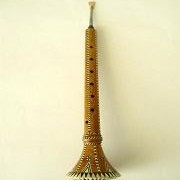Surnay overview
 Surnai (pinyin: bā lā màn) is the Xinjiang suona, which is a double-reed air-sounding instrument of Uyghur, Uzbek and other ethnic groups. Uyghur is called Surnai and Suonai, and there are various translations such as Suona, Suona, Suona, Suona and so on. Common name trumpet. Popular in Xinjiang Uygur Autonomous Region.
Surnai (pinyin: bā lā màn) is the Xinjiang suona, which is a double-reed air-sounding instrument of Uyghur, Uzbek and other ethnic groups. Uyghur is called Surnai and Suonai, and there are various translations such as Suona, Suona, Suona, Suona and so on. Common name trumpet. Popular in Xinjiang Uygur Autonomous Region.With a long history, Surnai was first seen in the murals in Cave 38 of the Kizil Thousand Buddha Caves in Baicheng, Xinjiang, with images of musicians playing Surnai. This grotto group was excavated in the 3rd century AD and is the earliest large-scale Thousand Buddha Cave in my country. This shows that suona has been spread in the Western Regions of Qiuci (now Kuqa area) during the Jin Dynasty (265-420 AD). The records of Surnai in Chinese historical records are relatively late, and they only appeared in the Ming Dynasty. Wang Xilou's "Research on the Past Daoist Jinle": "The trumpet, the lock, the song is small, and the melody is big."
The wooden suona is composed of a tube body, a core, a gas card and a whistle (pictured), with a total height of 46 cm. The tube body is made of wood, and the whole body is made of hard pear wood, apple wood or jujube wood. The height of the tube is 38 cm to 40 cm. The bell mouth is bell-shaped, but the bell mouth is small. The tube body and the bell mouth are connected as a whole. There are seven or eight (all with a back hole) circular sound-pressing holes on the tube body. The first hole is inclined to the left of the hole row, so that the little finger can press the hole, and the back hole is set above the corresponding position of the seventh hole on the front, which is the pronunciation hole for controlling the treble. A core is inserted into the pipe opening at the upper end of the pipe head. The core is made of copper, is a hollow cone, the core is 5 cm long, the upper mouth is placed with a whistle, the middle is sleeved with a gas card, and the lower mouth is inserted into the upper mouth of the tube body. Air badges are oblate and made of plexiglass or plastic. The pipe whistle is a double-reed reed made of reed, and the lower end of the whistle is sleeved outside the upper mouth of the core. The whole body of the wooden suona is twisted with lines or carved with patterns, and its appearance is exquisite and beautiful. In the Yili area of northern Xinjiang, the surnai with wooden poles and copper trumpet mouths is mostly used, which is the same as the suona in the Han area.
- Chinese name:Surnay
- Commonly known as:trumpet
- type:double-reed air instrument
- pinyin:sū ěr nài
overview of other similar instruments
- sanyanxiao overview
- Daguangxian overview
- Leiqin overview
- hahao overview
- yandundagu overview
- Han Xiaozheng overview
- Fang Xiang overview
- guanzi overview
- zhuqin (Dao Qin) overview
- zhuiqin overview
- bangzi overview
- three-stringed piano overview
- Gehu overview
- xiao overview
- xiaokonghou overview
- Konghou overview
- Sheng overview
- suona overview
- hulusi overview
- gushao overview
 渝公网安备 50010702504639号
渝公网安备 50010702504639号